-

Recognizing Text-Based Traffic Signs
J. Greenhalgh and M. Mirmehdi
(2014). ArticleRecognizing Text-Based Traffic Signs. Num.16, n. 3, pp. 1360-1369
We propose a novel system for the automatic detection and recognition of text in traffic signs. Scene structure is used to define search regions within the image, in which traffic sign candidates are then found. Maximally stable extremal regions (MSERs) and hue, saturation, and value color thresholding are used to locate a large number of candidates, which are then reduced by applying constraints based on temporal and structural information. A recognition stage interprets the text contained within detected candidate regions. Individual text characters are detected as MSERs and are grouped into lines, before being interpreted using optical character recognition (OCR). Recognition accuracy is...
We propose a novel system for the automatic detection and recognition of text in traffic signs. Scene structure is used to define search regions within the image, in which traffic sign candidates are then found. Maximally stable extremal regions (MSERs) and hue, saturation, and value color thresholding are used to locate a large number of candidates, which are then reduced by applying constraints based on temporal and structural information. A recognition stage interprets the text contained within detected candidate regions. Individual text characters are detected as MSERs and are grouped into lines, before being interpreted using optical character recognition (OCR). Recognition accuracy is vastly improved through the temporal fusion of text results across consecutive frames. The method is comparatively evaluated and achieves an overall Fmeasure of 0.87.
Llegir més Ocultar DOI: 10.1109/TITS.2014.2363167 -
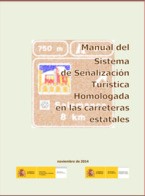
Manual del sistema de señalización turística homologada en las carreteras estatales
España. Ministerio de Fomento ; Ministerio de Industria, Energía y Turismo.
(2014). LlibreDocument de caràcter tècnic que estableix disposicions per a l'aplicació del sistema de senyalització turística homologada en les carreteres estatals (SISTHO), contemplant les operacions materials, jurídiques, tècniques i de disseny per a la seua implantació. Aquest sistema de senyalització permet informar els ciutadans en trànsit dels llocs que en la proximitat del seu recorregut tingueren un especial interés turístic, ajudant a potenciar l'oferta turística existent en tot el territori nacional, així com a facilitar la presa de decisions del viatger.
-
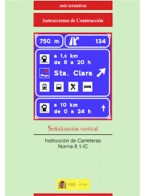
Señalización vertical. Instrucción de Carreteras, Norma 8.1-IC
España. Ministerio de Transportes, Movilidad y Agenda Urbana.
(2014). LlibreSeñalización vertical. Instrucción de Carreteras, Norma 8.1-IC.
Document normatiu de caràcter tècnic, el contingut del qual es refereix a la senyalització vertical de la Xarxa de Carreteres de l'Estat, en el qual s'estableixen els principis bàsics de senyalització, les característiques generals de tipologia, visibilitat, proteccions, entre altres, que es requereixen als senyals verticals, així com les especificacions particulars d'aplicació a diferents tipus de carreteres i infraestructures específiques, i altres de senyalització específica (velocitat màxima, avançament, passos a nivell…) i d'abalisament en corbes.
-

A VANET based intelligent road traffic signalling system. In Australasian Telecommunication Networks and Applications Conference (ATNAC)
Nafi, N. S., & Khan, J. Y.
(2012). ArticleIEEE Xplore. Australasian Telecommunication Networks and Applications Conference (ATNAC). Num.pp. 1-6
Road Traffic Information System is a key component of the modern intelligent transportation system. Road signaling systems can be made more efficient if real time information from different road sensors and vehicles can be fed in to a wide area controller to optimize the traffic flow, journey time, as well as safety of road users. The VANET architecture provides an excellent framework to develop an advanced road traffic signaling system. In this paper we present a unique VANET based road traffic signaling system that could significantly improve traffic flow, energy efficiency and safety of road users. The VANET based system has been developed using a distributed architecture by...
Road Traffic Information System is a key component of the modern intelligent transportation system. Road signaling systems can be made more efficient if real time information from different road sensors and vehicles can be fed in to a wide area controller to optimize the traffic flow, journey time, as well as safety of road users. The VANET architecture provides an excellent framework to develop an advanced road traffic signaling system. In this paper we present a unique VANET based road traffic signaling system that could significantly improve traffic flow, energy efficiency and safety of road users. The VANET based system has been developed using a distributed architecture by incorporating the distributed networking feature. In this paper we first introduce a new Intelligent Road Traffic Signaling System (IRTSS) system based on the VANET architecture. The paper presents some initial simulation results which are obtained by using an OPNET based simulation model. Simulation results show that the proposed architecture can efficiently serve road traffic using the 802.11p based VANET network.
Llegir més Ocultar DOI: 10.1109/ATNAC.2012.6398066 -
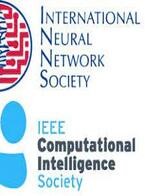
Detection of traffic signs in real-world images: The German traffic sign detection benchmark
S. Houben, J. Stallkamp, J. Salmen, M. Schlipsing and C. Igel
(2014). ArticleInternational Joint Conference on Neural Network (IJCNN). Num.(2013) pp.1-8
Real-time detection of traffic signs, the task of pinpointing a traffic sign's location in natural images, is a challenging computer vision task of high industrial relevance. Various algorithms have been proposed, and advanced driver assistance systems supporting detection and recognition of traffic signs have reached the market. Despite the many competing approaches, there is no clear consensus on what the state-of-the-art in this field is. This can be accounted to the lack of comprehensive, unbiased comparisons of those methods. We aim at closing this gap by the “German Traffic Sign Detection Benchmark” presented as a competition at IJCNN 2013 (International Joint Conference on Neural...
Real-time detection of traffic signs, the task of pinpointing a traffic sign's location in natural images, is a challenging computer vision task of high industrial relevance. Various algorithms have been proposed, and advanced driver assistance systems supporting detection and recognition of traffic signs have reached the market. Despite the many competing approaches, there is no clear consensus on what the state-of-the-art in this field is. This can be accounted to the lack of comprehensive, unbiased comparisons of those methods. We aim at closing this gap by the “German Traffic Sign Detection Benchmark” presented as a competition at IJCNN 2013 (International Joint Conference on Neural Networks). We introduce a real-world benchmark data set for traffic sign detection together with carefully chosen evaluation metrics, baseline results, and a web-interface for comparing approaches. In our evaluation, we separate sign detection from classification, but still measure the performance on relevant categories of signs to allow for benchmarking specialized solutions. The considered baseline algorithms represent some of the most popular detection approaches such as the Viola-Jones detector based on Haar features and a linear classifier relying on HOG descriptors. Further, a recently proposed problem-specific algorithm exploiting shape and color in a model-based Houghlike voting scheme is evaluated. Finally, we present the best-performing algorithms of the IJCNN competition.
Llegir més Ocultar DOI: 10.1109/IJCNN.2013.6706807 -
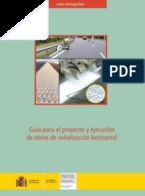
Guía para el proyecto y ejecución de obras de señalización horizontal
España. Ministerio de Fomento
(2012). LlibreGuía para el proyecto y ejecución de obras de señalización horizontal.
Document de caràcter tècnic que proporciona una guia per a les principals qüestions a considerar durant la planificació, execució i manteniment d'obres de senyalització horitzontal de la xarxa de carreteres de l'Estat. El document proporciona criteris, segons diferents fases de les obres, relatius als requisits de les marques viàries i els seus materials, equips de maquinària, operacions prèvies, els relacionats amb la traçabilitat dels treballs, el control i les condicions d'aplicació i manteniment, entre altres.
-
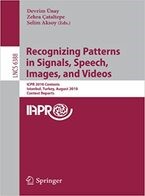
Road Sign Detection in Images: A Case Study
R. Belaroussi, P. Foucher, J. Tarel, B. Soheilian, P. Charbonnier and N. Paparoditis
(2010). Article20th International Conference on Pattern Recognition. Num.(2010) pp. 484-488
Road sign identification in images is an important issue, in particular for vehicle safety applications. It is usually tackled in three stages: detection, recognition and tracking, and evaluated as a whole. To progress towards better algorithms, we focus in this paper on the first stage of the process, namely road sign detection. More specifically, we compare, on the same ground-truth image database, results obtained by three algorithms that sample different state-of-the-art approaches. The three tested algorithms: Contour Fitting, Radial Symmetry Transform, and pair-wise voting scheme, all use color and edge information and are based on geometrical models of road signs. The test dataset is...
Road sign identification in images is an important issue, in particular for vehicle safety applications. It is usually tackled in three stages: detection, recognition and tracking, and evaluated as a whole. To progress towards better algorithms, we focus in this paper on the first stage of the process, namely road sign detection. More specifically, we compare, on the same ground-truth image database, results obtained by three algorithms that sample different state-of-the-art approaches. The three tested algorithms: Contour Fitting, Radial Symmetry Transform, and pair-wise voting scheme, all use color and edge information and are based on geometrical models of road signs. The test dataset is made of 847 images 960×1080 of complex urban scenes (available at www.itowns.fr/benchmarking.html). They feature 251 road signs of different shapes (circular, rectangular, triangular), sizes and types. The pros and cons of the three algorithms are discussed, allowing to draw new research perspectives.
Llegir més Ocultar DOI: 10.1109/ICPR.2010.1125 -
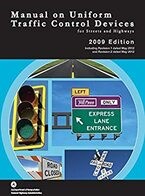
Manual on Uniform Traffic Control Devices (MUTCD)
Federal Highway Administration ; U.S. Department of Transportation.
(2009). LlibreManual on Uniform Traffic Control Devices (MUTCD).
Document de caràcter tècnic, d'obligat compliment als Estats Units, en el qual s'especifiquen els estàndards per al disseny, instal·lació i utilització dels senyals verticals de trànsit, les marques en la superfície de la carretera i altres senyals. Aquestes especificacions inclouen les formes, colors i fonts que s'utilitzen en les marques i senyals viaris. L'extens Manual també estableix disposicions relatives a la senyalització emprada per al control temporal de trànsit, en zones escolars, en encreuaments amb vies ferroviàries, i en infraestructura destinada a la circulació amb bicicleta.
-
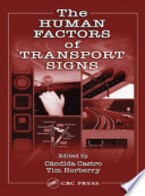
The human factors of transport signs
Castro, C., & Horberry, T. (Eds.)
(2004). LlibreThe human factors of transport signs.
Aquest llibre explora la investigació de senyals de transport. Si bé es concentren principalment en l'entorn viari i els problemes generals de senyalització, els autors també aborden temes específics de ferrocarrils i altres modalitats de transport. Els col·laboradors internacionals discuteixen la psicologia del conductor i la interacció amb els senyals de transport, així com les fortaleses i febleses dels diferents tipus de senyals.
ISBN: 0-203-34060-4 -

Effect of geometric design consistency on road safety
Ng, J. C. & Sayed, T.
(2004). ArticleCanadian Journal of Civil Engineering. Num.31(2), pp. 218-227
Geometric design consistency is emerging as an important rule in highway design. Identifying and treating any inconsistency on a highway can significantly improve its safety performance. Considerable research has been undertaken to explore this concept including identifying potential consistency measures and developing models to estimate them. However, little work has been carried out to quantify the safety benefits of geometric design consistency. The objectives of this study are to investigate and quantify the relationship between design consistency and road safety. A comprehensive accident and geometric design database of two-lane rural highways is used to investigate the effect of...
Geometric design consistency is emerging as an important rule in highway design. Identifying and treating any inconsistency on a highway can significantly improve its safety performance. Considerable research has been undertaken to explore this concept including identifying potential consistency measures and developing models to estimate them. However, little work has been carried out to quantify the safety benefits of geometric design consistency. The objectives of this study are to investigate and quantify the relationship between design consistency and road safety. A comprehensive accident and geometric design database of two-lane rural highways is used to investigate the effect of several design consistency measures on road safety. Several accident prediction models that incorporate design consistency measures are developed. The generalized linear regression approach is used for model development. The models can be used as a quantitative tool for the evaluation of the impact of design consistency on road safety. An application is presented where the ability of accident prediction models that incorporate design consistency measures is compared with those that rely on geometric design characteristics. It is found that models that explicitly consider design consistency may identify the inconsistencies more effectively and reflect the resulting impacts on safety more accurately than those that do not.Key words: geometric design consistency, road safety, quantification, accident prediction models.
Llegir més Ocultar DOI: 10.1139/l03-090






